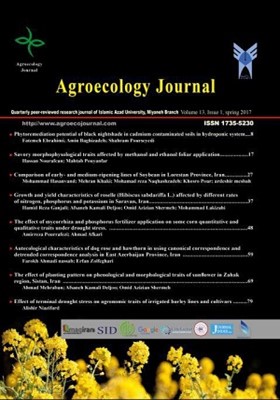Binomial sequential sampling model to facilitate monitoring of greenbug, Schizaphis graminum (Rondani) populations in broom corn farms
Subject Areas : Agroecology JournalShahram Shahrokhi Khaneghah 1 , Habibollah Khodabandeh 2
1 - Iranian Research Institute of Plant Protection, Agricultural Research, Education and Extension Organization (AREEO), Tehran, Iran.
2 - M. Sc. in Entomology, Islamic Azad University, Miyaneh Branch
Keywords: spatial distribution, population estimation, monitoring, corn leaf aphid, integrated pest management,
Abstract :
This study was conducted to develop a binomial (presence-non presence) sequential sampling model for saving time in determining population density of greenbug, Schizaphis graminum (Rondani) in broom corn fields. For this purpose 50 broom corn stems were sampled every three days for counting the aphid number. The mean and variance of population at each sampling date were used to estimate spatial dispersion parameters. Then, Taylor’s Power Law parameters were used to prepare binomial sequential sampling models at two precision levels of 0.10 and 0.25. The spatial distribution of S. graminum in the field was clumped and its mean population at different sampling dates ranged from 0.14 to 25.45 aphids per stem. Comparison of models showed that sample size required for estimating aphid population increased by reducing the precision level from 0.25 to 010, significantly. Therefore, the binomial sequential sampling model at the precision level of 0.10 was very time consuming and was not suitable for estimating aphid population density. However, the model at 0.25 precision level reduced the sample size required compared to the fixed sample size method. Overall, using binomial sequential sampling model at 25% precision level, the proposed precision level for pest management programs, can reduce sampling time in comparison to the fixed sample size method and it is recommended to estimate the pest population in integrated pest management programs in broom corn farms.


